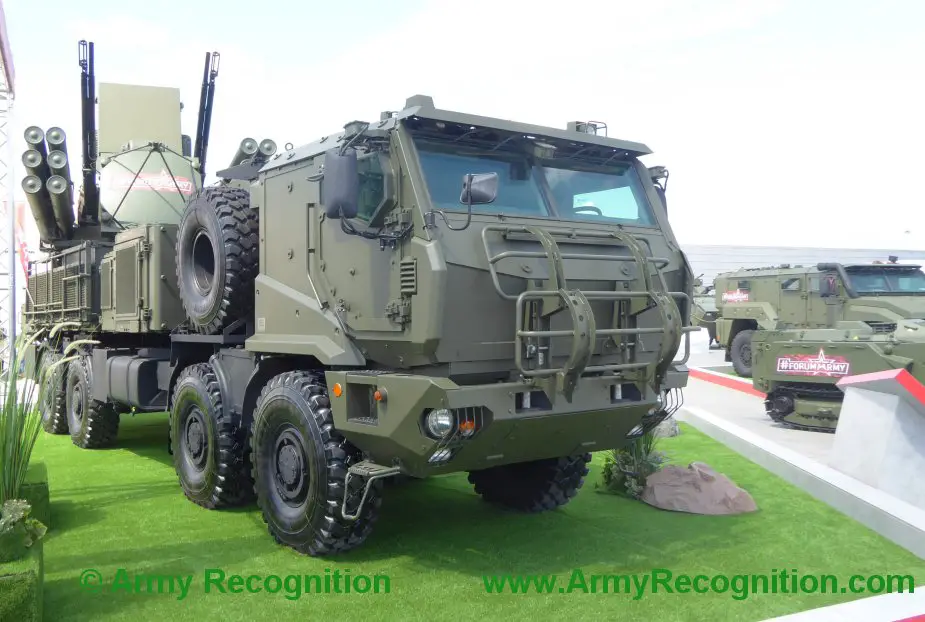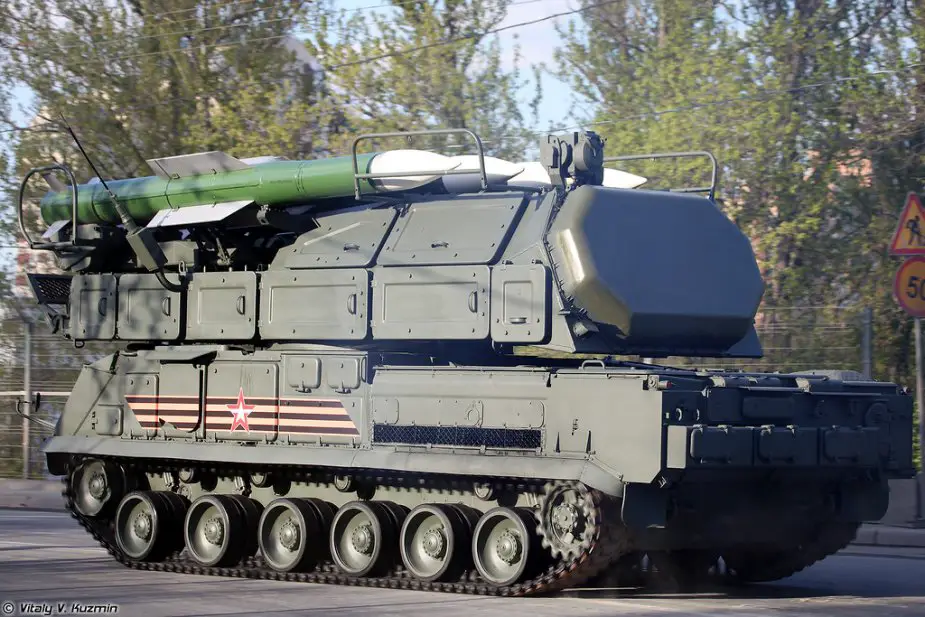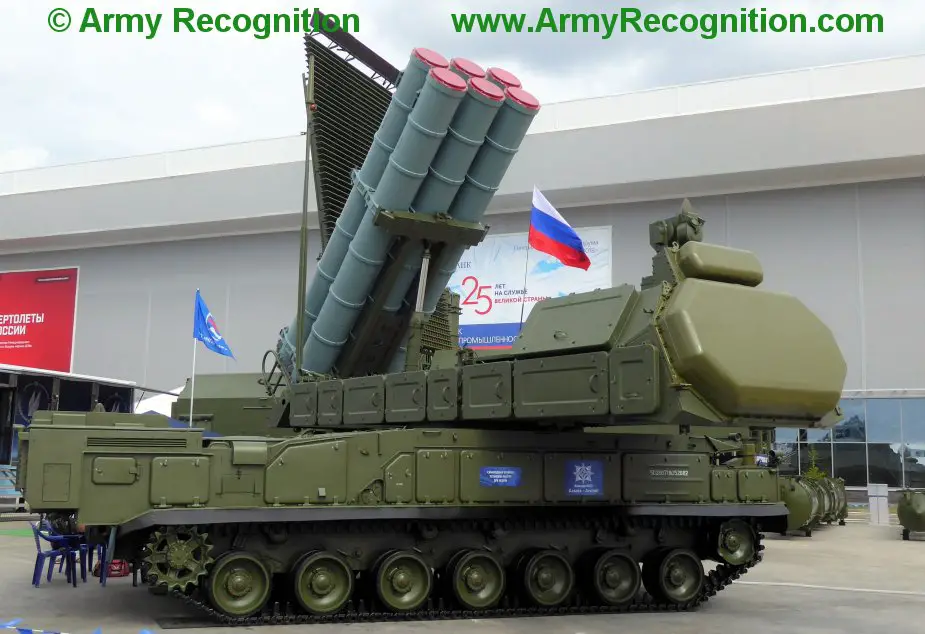Russian Ground Forces to receive tracked Pantsir air defense systems - Part 1
Russian S-300V and upgraded S-300V4 air defense launchers will receive short-range air protection. It will be an option of Pantsir launcher upgraded for the Ground Forces. Pantsir-SM/SV will have a tracked undercarriage instead of a wheeled one like the Pantsir-S1, the Independent Military Review writes. The ground option has to defend S-300V and S-300V4 against cruise missiles, precision weapons and combat drones. The 30mm Pantsir guns will also fight attacks on S-300V on the march and in positions.
Follow Army Recognition on Google News at this link

Pantsir-SM displayed at Army-2019 defense forum. A tracked version will be developed (Picture source: Army Recognition)
Protection of S-300V4s has become vital. They are the most dangerous weapon capable of destroying targets at a distance of 400 km. S-300V4 is the most effective weapon against ballistic missiles and is equipped with special radars to detect them.
The Defense Ministry is building up the air defense capabilities of operational and tactical forces. Several S-300V4 brigades have been recently deployed. They were « exotic » in early 2010s, but are now broadly engaged. Each combined arms army has its own air defense missile brigade armed with Buk-M2 and Buk-M3.
Since 2014, the Defense Ministry has been paying much attention to air defense in combined arms armies. In 2015, a new antiaircraft brigade was formed in the 49th combined arms army. The personnel were trained in the 106th air defense center in Orenburg. The brigade trained live fire at Kapustin Yar range. In December 2015, a new antiaircraft brigade joined the 36th combined arms army in Buryatia. The personnel completed training to operate Buk-M2 and conducted first live fire.

9A39M1 launcher-loader vehicle for Buk-M1-2 Air defence system (Picture source: Vitaly Kuzmin)
The Ground Forces will get another air defense missile brigade in a year or two. It will operate in the 8th combined arms army of the Southern Military District. Its creation began three years ago and the army does not have a proper set of units yet, including an antiaircraft missile brigade. However, media reports said the new air defense brigade had been formed and is operating Buk-M3.
Until recently, the air defense of the Ground Forces has mostly operated Buk-M1/M2 which were accepted into service in 1998. Now, the air defense brigades are rearmed with modern Buk-M2s and Buk-M3s. The Defense Ministry said the Ground Forces received five brigade sets of the new launchers in 2012-2019. It did not specify the number of supplied Buk-M2 and Buk-M3.

9A316 transporter erector launcher and transloader for Buk-M2 air defence system (Picture source: Vitaly Kuzmin)
Buk-M2 design began in 1988, but the launchers were accepted zinto service 20 years later. The first brigade set was supplied to the missile brigade of the 2nd Combined Arms Army in 2011. The Defense Ministry and Almaz-Antey signed a contract in 2013 for the delivery of three Buk-M2 brigade sets. They rearmed all available antiaircraft brigades. The first two sets were supplied to brigades formed from scratch. Buk-M2 was upgraded in the past years and received a target illumination and guidance radar. It expanded the radio horizon at extremely low altitudes and increased the destruction range of cruise missiles. Each vehicle detects, identifies and simultaneously fires at four targets from an unequipped position.

9A317M TELAR of 9K317M Buk-M3 air defence missile system displayed at Army-2018 defense forum (Picture source: Army Recognition)
Buk-M3 was accepted into service in 2016. The main difference from Buk-M2 is that it carries missiles in transportation-launcher containers. The round of munitions increased, as well as the destruction range. The system hits air targets at a distance of 70 kilometers. Buk-M3 exceeds predecessors 2-3 times due to multirole radar with a phased antenna array. One self-propelled launcher can attack six targets at a time.
The Defense Ministry publishes little data on the rearmament of the air defense of the Ground Forces. A comparison of available data with the statistical publication shows the ministry received two brigade sets of the latest launchers by 2019.
In late 2017, the antiaircraft missile formation of the combined arms army of the Western Military District deployed in Kursk region began to receive the first Buk-M3. It was reported in 2018 that the air defense unit of the combined arms formation of the Southern Military District deployed in North Caucasus held a tactical exercise. Buk-M3 repelled an air strike. The first batch of Buk-M3 was supplied to the Central Military District. The antiaircraft brigade of the 41st combined arms army deployed in Altai received the launchers.
The data show that the Defense Ministry received more than two brigade sets of Buk-M3. However, most air defense units likely receive battalion rather than complete brigade sets. The Defense Ministry said in early 2019 that producers will hand over a brigade set of S-300V4 and battalion sets of Buk-M3 and Tor-M2.
Therefore, antiaircraft brigades can simultaneously operate battalions of Buk-M1-2, Buk-M2 and Buk-M3. It may look incredible at first sight, but one has to remember that all Buk launchers can operate autonomously. The combat vehicles have target illumination and detection radars. They autonomously detect, identify and destroy targets.
© Copyright 2020 TASS / Army Recognition Group SPRL. All rights reserved. This material may not be published, broadcast, rewritten or redistributed.


























